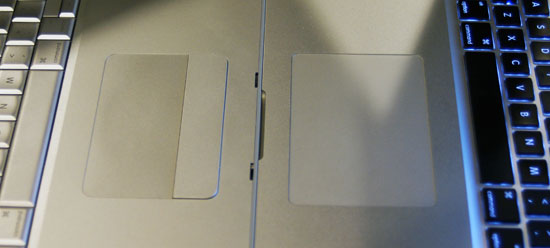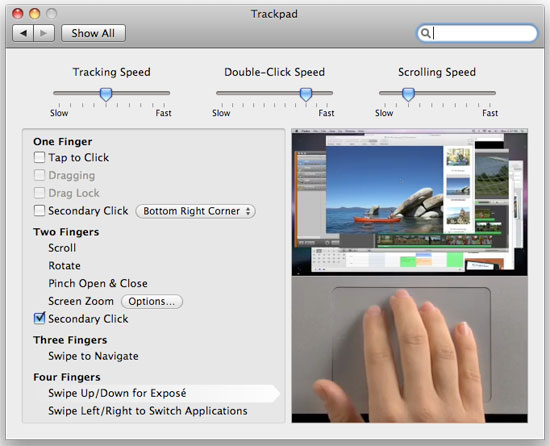Apple's Redesigned MacBook and MacBook Pro: Thoroughly Reviewed
by Anand Lal Shimpi on October 22, 2008 12:00 AM EST- Posted in
- Mac
Baby Steps: The New Trackpad
With the MacBook Air, Apple introduced its first oversized trackpad:

The MacBook Air's trackpad
The size was necessary to enable more complex gestures; you could now rotate pictures just using two fingers and the trackpad. Neat. The MacBook Pro got the same functionality with its update earlier this year, and now with this last redesign both the MacBook and MacBook Pro have support for even more gestures.

The old MBP trackpad (left) vs. the new MBP trackpad (right)
Slide four fingers from top to bottom and you'll activate Exposé, slide them from left to right and you can switch between apps. The gestures are nice but are still gimmicky in my opinion; they aren't integrated well enough into OS X as the OS wasn't designed with them in mind. The usage experience I'm looking for is more Star Trek tablet - or iPhone like if you want a more realistic reference. I think we're getting there, and Apple is planting the seeds for such a transition, especially if you look at the sort of trackpad used on the new notebooks.

The new trackpad lacks any discrete buttons; instead, the entire pad can be depressed and acts as a physical mouse button. Keep one finger on the pad and push down on it for a single click, have two fingers on the pad and it's a right click. Scrolling is the best implementation I've seen on a trackpad; just take two fingers and move them up/down/left/right to scroll.
The pad is also covered with a thin piece of glass that makes gliding your finger on it much smoother, which is admittedly very nice. None of this is necessary for the current gestures but it gives us a good indication of where Apple is going with this. It won't be this year, it may not even be next year, but real multi-touch is coming to OS X. Wake me up when that day comes, because until then this bandaid of gestures isn't going to win me over.
While I wasn't won over by the gestures, I would be fine with the new trackpad if it didn't have so many problems. I have had some issues with clicks not registering; I'm not sure if this is a hardware problem or a software one. The trackpad would physically click but the click wouldn't register in OS X. This problem appeared more on the MacBook Pro than the MacBook, and it didn't matter where I clicked on the pad, it just wouldn't register. Eventually it would sort itself out and everything would be back to normal. It seems like other users are running into this same problem and Apple appears to be replacing notebooks, but there's no indication that it's actually a hardware issue. I'd suspect it's a software problem but it's honestly too early to tell. So far it seems like if you take your finger off of the pad before you click, then put it back on to click you're more likely to make the click register. Or simply enable tap-to-click and you'll avoid the problems altogether - not a real solution in my opinion but a workaround.
The trackpad is even worse under Windows for some reason. If you try pushing down on the pad to make it click under Windows, the cursor has a tendency to jump while it is very well behaved under OS X. Again, I have a feeling this is more of a software problem but who knows if/when it will be fixed.
Hooray for being an early adopter of Apple's finicky product.










66 Comments
View All Comments
plonk420 - Thursday, October 23, 2008 - link
could anyone test this with the new (and even old) Mac Book Pro to test for CPU usage?http://www.megaupload.com/?d=ADFYX083">http://www.megaupload.com/?d=ADFYX083
h.264 high profile (QT supports this now, right?) level 4.1 720p60, fairlight/the black lotus's demo Only One Wish (2nd place at Intel's second demo compo) .. has some really handsome bitrate spikes :D ~mid 20s mbps spikes (but not as good as the 60mbit spikes in a 6 or 8mbit (average) encode of ASD's Antisize Matters)
michaelheath - Thursday, October 23, 2008 - link
Having spoken to a few Apple developers I know, the reason for this oddity is Nvidia's software implementation for Mac OS 10.5. While the ideal situation was for them to be able to switch on the fly, the agreement between Apple and Nvidia to develop for the new MacBooks and MacBook Pros happened so quickly it left little time to create a proper application that would allow for this (think of how you had to restart your computer to turn SLI on or off: same slapdash type of programming).The hope is that quick-toggling between integrated and dedicated graphics will come with Mac OS 10.6 as it may be too large of an update to patch Mac OS 10.5. It also makes sense in this aspect as Mac OS 10.6 also includes OpenCL GPGPU algorithms, which Nvidia is already promoting and developing under their CUDA platform.
RDO CA - Thursday, October 23, 2008 - link
On my Thinkpad T-400 with switchable graphics all that is needed to switch is to go to the taskbar icon and click switchable graphics and choose what you want and the screen goes dark for a second and thats it.cliffa3 - Thursday, October 23, 2008 - link
I'll test it sometime this week, but on my Lenovo T61 it seems like I get much more life out of Ubuntu than I do Vista 64-bit. Could be a windows thing in general, not just something that OS X does better.How was the battery life comparison between XP and Vista?
PilgrimShadow - Thursday, October 23, 2008 - link
Anyone know if the 9400M and 9600M appear in Vista's Device Manager?TallCoolOne - Thursday, October 23, 2008 - link
I bought the new 2.0GHz MacBook last week as my first Mac and can say I'm not disappointed. The whole chassis feels as solid as, well, a block of aluminum! As Anand said, it feels like you get what you paid for. I actually like the multi-touch gestures, such as swiping with 3 fingers to flip pages and for back/forward when web browsing. I'd like to see iTunes also support that gesture. Two finger scolling is another great feature not mentioned in this article. What I don't like though is the stiffness of the mouse click. It takes far more pressure than any mouse and that required pressure is uneven in different areas of the trackpad. Pressing near the top requires more pressure than near the bottom. As for lack of standard SSD, Anand, perhaps you're a little too spoiled by that speed! I would not expect that as standard on even the fastest MacBook Pro at current prices. That is, unless you'd like to see the asking price for a MBP $500-600 more than it is now.vlado08 - Thursday, October 23, 2008 - link
It is interesting was vista side panel running during the test. Also was this fresh install of vista os. If it was fresh then was the indeing enabled.vlado08 - Thursday, October 23, 2008 - link
edit indeing - indexingjmpt2 - Thursday, October 23, 2008 - link
Very interesting to read your conclusions about better power management in MacOS vs Vista. This matches my experiences running Vista on the BootCamp partition of my Core Duo MacBook, and is the first time I've seen this discussed anywhere on the web. I found that with a main battery in quite poor condition after two years constant use, it became impossible to use Vista on battery power for more than a minute without the battery deciding it was empty and putting the machine into sleep mode. Under MacOSX the system could still be used for 30min+ (light use) before the same thing happened.I'd come to the conclusion that Apple were deliberately playing games with the ACPI tables to confuse Vista's power management code and make their own OS look better. This seemed to be supported by the fact that Vista is unable to correctly detect the charging state on my MacBook - running on battery power it would always report "Connected to mains, not charging". Does it still work that way on the latest MacBooks? In any case, your data does seems to suggest the problem is a more general issue with Vista. Sounds like you should investigate further...
BZDTemp - Thursday, October 23, 2008 - link
I wonder if OS X lasting longer on a battery can be transfered to the world of none portable?In other words say I run OS X on my daily, none laptop, work machine doing surfing, writing and perhaps listening to music(FLAC prefered over MP3) or even watching an episode of The Daily Show. Will this draw less power from the wall with a PC running OS X than with the same machine running Windows (and is there a difference between Windows versions). Also Linux should be included in the test.
Imagine the perspective - with the whole green computing movement this could really make a difference not just in the server rooms.
Please do check this out - this is not only interesting for us geeks but could make Anandtech something referred to by none-tech news media.